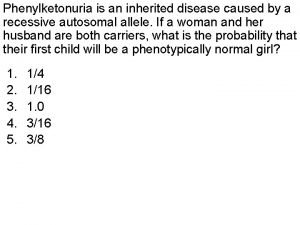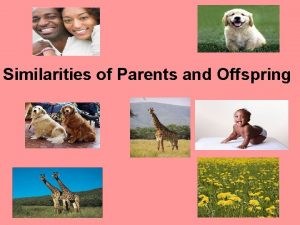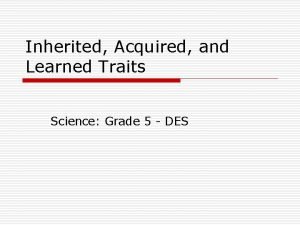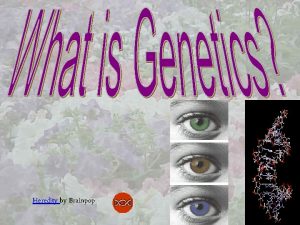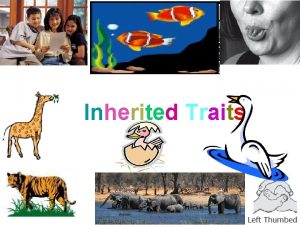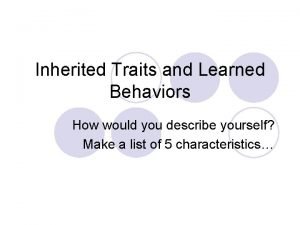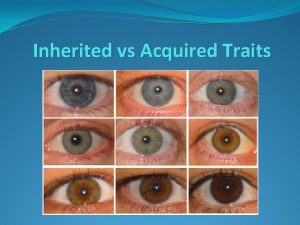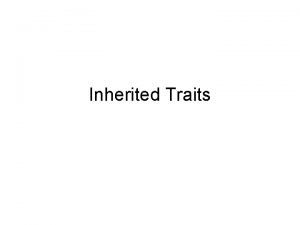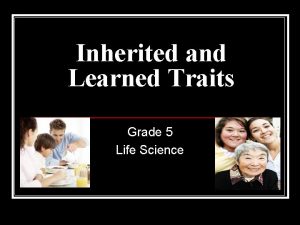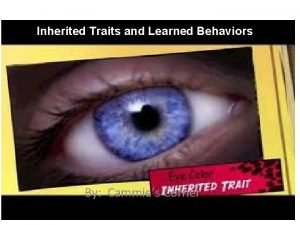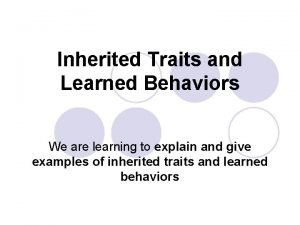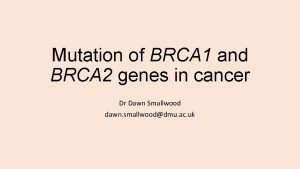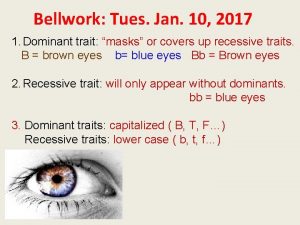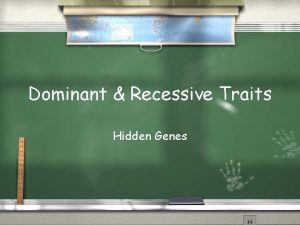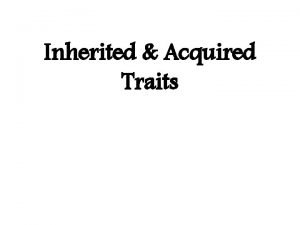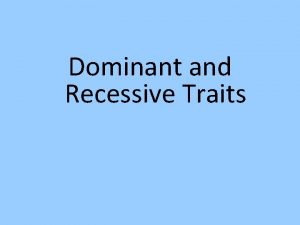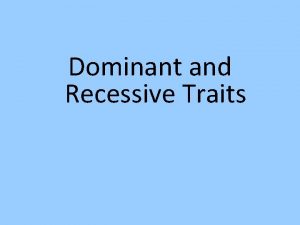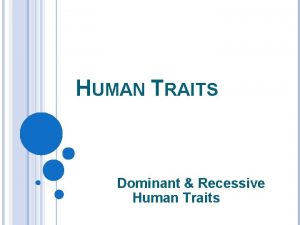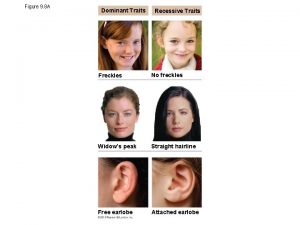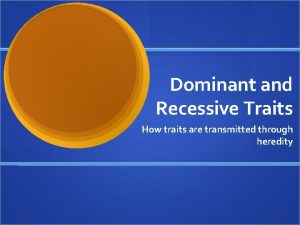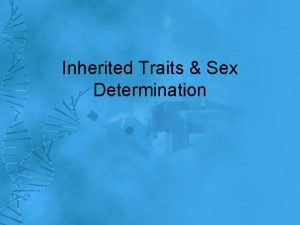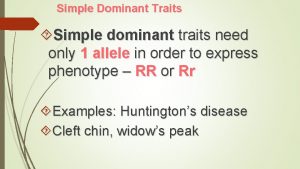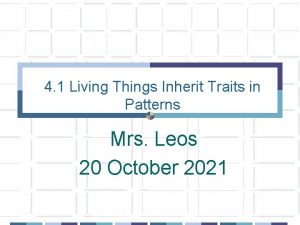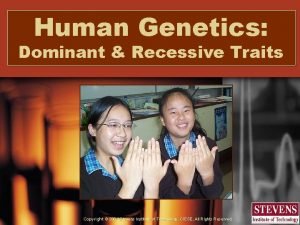Dominant or Recessive Inherited Traits Living things inherit
















- Slides: 16


Dominant or Recessive?

Inherited Traits Living things inherit traits, or characteristics/parents. Ex. – Eye color, hair color, flower color. Genes and Chromosomes Genes – Hereditary information. What else do genes do? Determine traits of an organism - Ex. Shape of ears, you have a backbone/legs, hair color Genotype and Phenotype Genotype – Genes passed to offspring. Phenotype – Physical appearance. Ex. Black hair Genotype determines Phenotype. Genes are located on Chromosomes – Hold genetic info. 1 chromosome contains many different genes.

More on Genes and Chromosomes Cells in different kinds of organisms contain different numbers of chromosomes. Ex. – Cats – 38 / Dogs - 78 Human baby = 23 chromosomes from mom/23 from dad. Human body cells=46 chromosomes in 23 pairs. Each pair has a number from 1 -23. Chromosome 1 from dad/mom have similar genetic information. This is true for the other 22 pairs.

Homologous Chromosomes Genes that determine a specific trait are in matching locations on paired, or homologous, chromosomes. Genes for ear shape are located in same place on 2 homologous chromosomes. Mom Dad

Dominant and Recessive Alleles Many traits are controlled by a single gene. Ex. - 1 gene = Earlobes attached 1 gene = Earlobes free Trait Different forms of same gene are called Alleles. Hair Type Alleles will be either: Dominant = Stronger Trait Recessive = Weaker Trait Hair Color Let’s look at the table to the right Earlobe for examples of human traits. Dimples Trait Made By By Dominant Recessive Allele Curly or Straight Wavy Dark Light Free Attached Present Not Present

Identifying Genotypes and Phenotypes Genotype for a trait is written as 2 letters. Capital letters = Dominant Alleles Lowercase letters = Recessive Alleles The allele that causes free earlobes is dominant over the allele for attached earlobes. So F is used for free earlobe gene. What do you think is used for attached earlobe gene? Lowercase f

Let’s Stop and Answer Some Questions 1. What do living things inherit and from where? 2. What are some things you can inherit from mom/dad? 3. What are genes? 4. What else do genes do? Give some examples. 5. What do the terms genotype and phenotype mean? 6. Genotype determines __________. 7. Where are genes located? 8. What is the job of chromosomes? 9. One chromosome contains many different _______. 10. How many chromosomes do we receive from mom/dad? For a total of? 11. What makes males and females different at the chromosome level? 12. How many pairs of chromosomes does each human cell have? 13. Describe how the chromosome pairs are numbered and how the genetic information is arranged. 14. What are homologous chromosomes? 15. What are alleles? 16. What is meant by the terms dominant and recessive? 17. Give some dominant and recessive traits. 18. How do you distinguish between dominant and recessive traits when written?

More on Genotypes and Phenotypes Offspring receive 2 copies of each gene-1 from each parent. 3 possible genotypes : FF, ff, or Ff. FF and ff = Homozygous Ff = Heterozygous “Homo” means “the same. ” Homozygous genotype – Made up of 2 dominant or 2 recessive alleles. Ex. - FF or ff “Hetero” means “different. ” Heterozygous genotype – Made up of 1 dominant and 1 recessive allele. Ex. - Ff

Do your ears hang low? If an organism inherits a dominant allele, the dominant trait is expressed. Allele for free earlobes = dominant. So, how would we write the genotype? FF and Ff ______________ How then would we write the genotype for attached earlobes? ff ______________

Using Punnett Squares Used to predict results of genetic crosses. Cross – Mating of 2 parent organisms Punnett Squares are used to calculate probability of genotypes/phenotypes in offspring.

Let’s make a Punnett Square with the information below. Task – Predict outcome of crossing tall pea plant with short pea plant. First, I must know the genotype of each parent plant. There are 3 possible genotypes : TT, Tt, and tt Genotype of pure tall plant : TT <---- It has 2 dominant alleles Genotype of pure short plant : tt <--- It has 2 recessive alleles. To make a Punnett Square, 1 st separate the parent alleles. Place 1 pair across top of square, and other pair down the left side. t t t T Tt Tt T tall Genotype - Genes Dominant Gene always 1 st in genotype t Phenotypes - physical

Sex Chromosomes In humans, females have 2 “X” chromosomes. So, each egg contains one “X” chromosome. Males have both an “X” and a “Y” chromosome. Each sperm cell contains either an “X” or a “Y” chromosome. XX = Female XY = Male

Let’s consider a cross between 2 plants with heterozygous genotypes : Tt x Tt t T T t TT Tall Tt Tall tt Short How many possible genotypes here? 3: TT, Tt, tt How many phenotypes? Tall , Short Probability of tall plants? 3 out of 4, or 75%. Probability of short plants? 1 out of 4, or 25%.


We’re done! Let’s answer some questions. 1. 2 different forms of the same gene are called A. phenotypes. C. dominant traits B. genotypes. D. alleles 2. An organism’s expressed traits make up its A. recessive traits C. phenotype B. genotype D. alleles 3. A pea plant that is homozygous dominant for seed color is crossed with a pea plant that is homozygous recessive for seed color. Since yellow is the dominant color, the letters Y and y represent the genes for seed color. What cross represents these 2 plants? A. Yy x Yy C. YY x yy B. YY x Yy D. Yy x yy 4. You meet a person and notice that she has dimples. What can you say for sure about the phenotypes of her parents? A. At least 1 of her parents has dimples. C. Neither parent has dimples. B. Both of her parents have dimples. D. 1 of her parents does not have dimples.
 Pku hereditary
Pku hereditary Is there a similarity between the parents and offspring
Is there a similarity between the parents and offspring He who overcomes will inherit all things
He who overcomes will inherit all things X linked recessive vs autosomal recessive pedigree
X linked recessive vs autosomal recessive pedigree Inherited and acquired traits
Inherited and acquired traits Inherited traits are brainpop
Inherited traits are brainpop Elephant inherited traits
Elephant inherited traits Learned behavior and inherited traits
Learned behavior and inherited traits Characteristics of an organism
Characteristics of an organism What inherited traits do elephants have
What inherited traits do elephants have Examples of acquired traits in humans
Examples of acquired traits in humans Bill nye inherited traits and learned behaviors
Bill nye inherited traits and learned behaviors Inherited traits and learned behaviors
Inherited traits and learned behaviors Difference between living and non living organisms
Difference between living and non living organisms The smallest living unit within the human body is
The smallest living unit within the human body is Is brca dominant or recessive
Is brca dominant or recessive Are thin lips dominant or recessive
Are thin lips dominant or recessive
